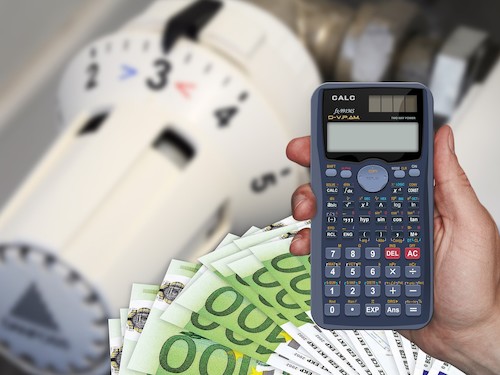94,000 households cannot adequately afford heating, and 115,500 households are particularly burdened by high energy costs – findings may inform the current debate
Energy affordability is playing an increasingly important role. “Not only in times of Corona, but in daily life regardless of the epidemic, there are so-called low-energy families in which either energy costs are above average with low household income or do not have the opportunity to adequately heat the apartment.”, E -Control Board of Directors, Wolfgang Urbantschitsch, explains. “Energy affordability is a very central area of electronic control and we have dealt with the issue of energy poverty for years. The so-called European Union Clean Energy Package, which of course should be implemented in Austria, states that energy poverty must be defined and measured. In order to be able to put in place measures to combat energy poverty. Therefore, as an additional contribution to the discussion on energy poverty, we have once again requested a study on this topic from the Austrian Statistics Authority, the results of which are currently available. ”
For the first time, this study compares two different measures of energy poverty. Not only is the discussion going on in Austria about energy poverty, but it also adds valuable information about the families involved to the level of knowledge. The two population groups affected by energy poverty are compared in different ways in order to learn more about the affected people and their housing situation.
2.4% of all households cannot heat adequately
Around 94,000 families, or 2.4% of all families in Austria, cannot afford to heat their homes adequately. This stems from the aforementioned study conducted by the Austrian Statistics Authority based on the Income and Living Conditions Survey (EU-SILC) from 2019. In 2010 the share was 3.7%. The average income of affected households is approximately 18,980 euros per year. “In the past ten years, the percentage of families who are unable to heat adequately due to their financial situation has decreased by a third,” she said. “However, 94,000 families remained cold before the Corona crisis, as they were often particularly affected by compulsory education.” Austrian Statistical Office Director-General Tobias Thomas.
Smaller and less educated families often cannot afford heating
Single-person households are often unable to afford adequate heating costs, while families with children are less likely to be able to afford adequate heating. Families with people without more than compulsory education are also the most affected. On average, 2.4% of all households were not able to adequately tolerate heating in 2019; Households with people without more than compulsory education were affected, at 5.9%. Among single-person households, the percentage of those who could not keep an apartment adequately warm was 4.3%.
115,500 low-income households are particularly burdened by rising energy costs
At the same time, there were 115,500 relatively low-income households in 2018 who at the same time had to incur above-average energy costs. These households had a household equivalent income of less than 15,437 euros per year, 60% of the average income, and at the same time had to pay equivalent energy costs in excess of 1,720 euros, which was equivalent to 140% of average energy costs. . The absolute energy consumption and associated costs increase with the increase in household income, while the proportion that is spent on energy decreases.
For the first time, the current study provides information on affordability
In the current study on behalf of E-Control, so-called low energy households with higher energy costs and lower household income were analyzed for the third time. So far, the focus has been exclusively on relatively low-income households as measured by average income and relatively high energy costs. However, relative measures of income say nothing of what families can afford. Additionally, households that have to give up energy to live from the start and thus tend to have low energy costs have not yet been taken into consideration. Therefore, in addition to the previous two reports, the current report also looked at those households that reported in the EU-SILC 2019 Survey that they could not afford enough energy to heat.
Energy poverty has many different aspects
The current study by the Austrian Statistics Authority has clearly shown that energy poverty is relatively stable on the one hand. Thus, current measures to combat energy poverty are as effective as energy poverty is not prevalent in Austria. However, it will not be suppressed by current measures.
The analyzes now available on the basis of two measures of energy poverty also show similarities and differences between groups of energy-poor households. “We are comparing a group of low-energy households who have to spend a lot of energy on low income with another group of low-energy households who say they cannot afford to heat their homes adequately,” explains the Electronic Control Board. The directors, Alphonse Haber, on the content of the study.
Moreover: “We have also seen that although energy poverty occurs in different forms, it tends to occur in the same population groups. For example, energy-poor households are found somewhat more often in the less educated classes. – Poor households in small one-person households are already above the population average. There are also distinct differences between energy-poor households and non-energy-poor households in Austria with regard to the housing situation. Energy-poor families generally live more often in older buildings, apartment buildings, smaller apartments, and rentals.
Energy poverty appears to establish itself in different ways
Interestingly, there are also indications of differences between the two groups of low-energy households in terms of living conditions, depending on whether one incurs or waives high energy costs with a lower income. “Although current data do not allow for an assessment to be conducted according to strict statistical criteria, we take the apparent differences between the two groups as a strong indication that energy poverty is already establishing itself in different ways in affected populations,” explains Alphonse Haber. The results indicate, for example, that the legal relationship to the apartment – that is, ownership or rent – can be crucial to whichever aspect of energy poverty is the outcome. The shape of the building (one / two family home or apartment building) or the usable area of the living space can have somewhat less influence on whether higher energy costs are still acceptable with lower incomes or whether there is a tendency to heat less.
“The important conclusion for us is that families with different living conditions and low incomes react differently to the high demand for energy and thus can take different paths to energy poverty. This also means that many indicators and measures are needed to deal with this issue. ., Suggests Alphonse Haber. “We at E-Control will certainly continue to pay close attention to energy poverty and energy affordability in the future,” he asserts. In the context of implementing the requirements from Brussels, it would be logical to define energy poverty more broadly and thus include families whose incomes fall below the poverty threshold, but at the same time face difficulties in being able to afford the necessary costs. Spending on household energy. “E-Control also advocates for a multi-dimensional recording of energy poverty. Objective indicators such as very high or very low energy expenditure should be combined with subjective indicators such as insufficient heating costs or outstanding energy debt.” Alphonse Haber wishes.
Waiver of green electricity costs helps energy-poor households
“Information and raising awareness about how to save energy can be a step towards helping poor families with energy. The most important here is information about the possibility of exemption from green electricity costs. Low-income families who are entitled to an exemption from ORF-GIS fees can apply for an exemption Full of green electricity costs at the same time the fee waiver application is submitted. This is still not used by all those affected. However, we are calling on low-income families to take advantage of this option. E-Control will be happy to provide you with information, ”Wolfgang Urbantschitsch concludes.
The study can be downloaded from the electronic control home page
Those: electronic control
The article was published online by: / Doris Holler /

“Total coffee aficionado. Travel buff. Music ninja. Bacon nerd. Beeraholic.”







More Stories
AMAG with sales and profits declining in the first quarter
Traditional FC Salzburg: Reaching old successes with a new coach?
Harald Wiel will take over as Group Vice President IT at Greiner from June 2024